Medicine and the Mediaã¢â‚¬â€Âmental Illness as Metaphor Yet Again
The findings from a previous study investigating the touch of dyslexia on practice learning were used to develop the content of two web-based reusable learning objects (RLOs). The aim was to provide students and mentors with evidence-based guidance and strategies for coping with dyslexia in the workplace. The RLOs were developed using a pedagogicalframework to guide the employ of media components, narratives and interactivity. The RLOs have been accessed past over 600 users, including students and mentors. Positive ratings and qualitative feedback suggest that the RLOs are of highquality and informative. Translation of research findings into RLOs is an effective way of achieving knowledge transfer. In this study the resources were developed for healthcare students, their mentors and others interested in finding out more about dyslexia. By releasing the RLOs equally open educational resource, the barriers associated with authentication and restrictive licensing are removed, enabling many more people to learn nearly dyslexia and the strategies for coping with dyslexia in the workplace.
What is known on this subject field
• Students and mentors require more information near what dyslexia is and how to cope with dyslexia in the workplace.
• Reusable learning objects (RLOs) can be effective in increasing knowledge and agreement.
• Use of a standardised quality-controlled development framework leads to RLOs that are fit for purpose.
What this paper adds
• It offers a rationale for translating research findings into open-access RLOs on dyslexia.
• It provides a clarification of the RLO evolution procedure for producing two RLOs aimed at raising sensation about dyslexia and providing guidance on coping with dyslexia in the workplace.
• It describes the benefits of the RLO format for users who want to find out more nearly dyslexia.
Key words
dyslexia, placement-based learning, reusable learning objects
Introduction
Dyslexia affects 3–10% of the population (Snowling, 2000), and many students are non identified as beingness dyslexic until they enter higher education (Wright, 2000). Students who are dyslexic are fairly well supported in their academic studies by their tutors and institutional academic back up units. However, in the exercise learning setting there is testify that students with dyslexia observe some tasks difficult (Potato, 2008; Illingworth, 2005; Sanderson-Isle of man et al, 2012). Although concerns accept been raised virtually whether clinicians with dyslexia pose any risk to patient safety, there is no bear witness of the correlation betwixt reduced functioning on certain tasks and dyslexia indicators translating into operation errors in practice (Millward et al, 2005).
An boosted trouble for students is that their exercise mentors may exist unaware of what dyslexia is (Wright, 2000; Price and Gale, 2004; Sanderson-Isle of man et al, 2012) and the means in which they tin can support dyslexic students under their supervision. A review by Shellenbarger (1993, cited in Millward et al, 2005) argued that it is neither practical nor cost-constructive to provide the level of back up required. In an era when the volume of show that needs to be considered by practitioners is constantly expanding, agreement dyslexia represents even so another task. And then, although useful toolkits (Cowan, 2010) and guidelines are bachelor, practitioners accept little time to spare to read through what can exist fairly dry documents. In our study (Sanderson-Mann et al, 2012), both students and mentors indicated that web-based learning resources would be a popular way to promote and disseminate the inquiry findings and raise awareness of dyslexia. In this article we describe how we have translated our research findings into 2 short multimedia-rich interactive spider web-based resource called reusable learning objects (RLOs) for students with dyslexia and their mentors.
Aims
These were equally follows:
i. to describe how the findings froma inquiry project designed to explore the difficulties experienced by students with dyslexia in exercise environments have been incorporated into two RLOs
2. to evaluate the employ of the RLOs when released as open educational resource.
Characteristics of RLOs
There are numerous definitions of RLOs (Wiley, 2000; Duncan, 2003). Our definition is as follows: 'an interactive multimedia web-based resources based on a unmarried learning objective which can be used in multiple contexts.' RLOs are bite-sized chunks of e-learning, focusing on a specific topic and offer flexibility in their apply. They are visual with an audio commentary and high-quality graphics, and accept the average learner about 15 minutes to consummate. Visual, audio and interactive resources appoint and back up learners, and a key strength is the interactive functionality that can promote a sense of command. Feedback to the user tin can improve feelings of competence and lead to changes in behaviour (Lymn et al, 2008). The power to visualise processes as computerised animations or videos appears to heighten learning, and increases test scores when compared with trying to empathise fromstatic text (Thatcher, 2006; Chew et al, 1994). The opportunity to choose from a selection of media to deliver the information is important, as learners prefer to exist in control of how they learn (Windle et al, 2010a), and information technology as well makes the RLOs peculiarly accessible for students with a inability such equally dyslexia, or who take a particular learning style (auditory, visual or kinaesthetic). RLOs are portable, can be loaded into VLEs, websites, CDs or memory sticks, and are hands accessible considering they are open educational resources (Windle et al, 2010b) requiring no authentication to access them.
RLO teaching and blueprint principles
The theoretical framework underpinning the pedagogical design of the RLOs is IMS Learning Pattern (Koper, 2003). This framework emphasises the environment in which the learning occurs, the roles played by the learner and the activities undertaken. IMS Learning Design ensures that the most appropriate multi-media environment is created, and that learners take an agile office within the RLO. The content is supported by help and feedback mechanisms; self-assessments permit learners to gauge their progress against the learning goals. The RLOs consist of a stand up-alone collection of iv key elements.
one. Presentation: the concepts and facts to be understood by the learner to support the learning objective are presented in text, audio and imagery formats.
ii. Activities: interactivities are carried out past the learners in order to enable them to engage with the content and improve their understanding.
iii. Self-cess: learners are able to apply and test their understanding of the content.
four. Resources: in that location are external links to further resources to reinforce the content and aid agreement.
RLO development methodology
The evolution and quality assurance process has been described in detail elsewhere (Boyle et al, 2007). Effigy 1 shows a schematic diagram of the process and is briefly described here. The testify-based content for the RLOs is identified post-obit a scoping process that may take one or more forms, for instance, workshops, literature reviews, or a bespoke piece of research every bit was the case in this study. The output of this start scoping stage was a storyboard which was so distilled into a written specification. The specification was peer (quality) reviewed past 2 content experts (in this case they were Disability Liaison Officers within the University ofNottingham) who likewise later reviewed (quality review 2) the image RLO post-obit the media development phase. Following various iterative review cycles the RLO was set for user evaluation with mentors and dyslexic students.
Dyslexia RLOs
The learning goal of the showtime RLO was to raise awareness of the positive characteristics of dyslexia and the different skills that thosewith dyslexia possess. The curt RLO uses images of famous dyslexic people in public life to emphasise their special talents. Other visual imagery is used to illustrate other traits and skills that dyslexic people have. Learners tin can complete interactive tasks to enable them to proceeds an insight into how it feels to have dyslexia. A screenshot from this RLO is shown in Effigy 2.
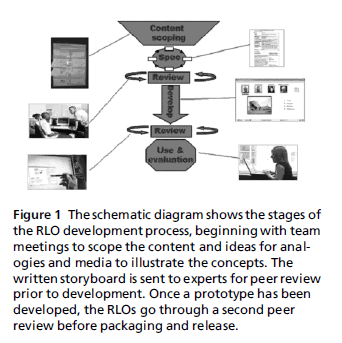
Figure i :The schematic diagram shows the stages of the RLO development process, get-go with team meetings to scope the content and ideas for analogies and media to illustrate the concepts. The written storyboard is sent to experts for peer review prior to development. One time a prototype has been developed, the RLOs become through a second peer review before packaging and release.
The second RLO (meet Figure 3) incorporated the findings from the research study (Sanderson-Mann et al, 2012), and the learning goal focused on strategies for coping with the difficulties that dyslexic students encounter when learning in the workplace. The RLO provides guidelines that mentors can use to help students to larn in this sometimes challenging environment. These were drawn directly from the inquiry findings, and truthful anonymised personal experiences from students with dyslexia were used to convey strategies for overcoming difficulties experienced during nursing placements. A simple colour changer that allows learners to cull their preferred background colour was added to both RLO interfaces. The two RLOs 'Understanding Dyslexia' (released in September 2005) and 'Dyslexia and Workplace Learning' (released in Jan 2007) are freely available under a Creative Commons licence (at world wide web.nottingham.ac.united kingdom/nmp/ sonet/rlos/placs/dyslexia1/index.html and www. nottingham.ac.great britain/nmp/sonet/rlos/placs/dyslexia2).
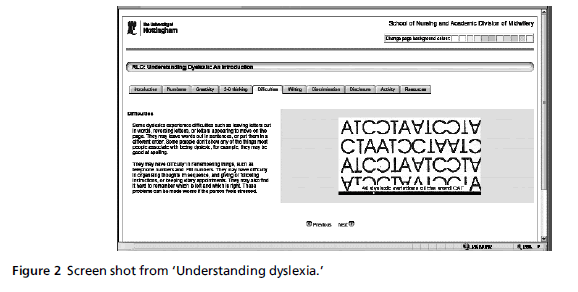
Figure 2 :Screen shot from ÃÆ'ƒÂ¢ÃÆ'‚€ÃÆ'‚ËœUnderstanding dyslexia.ÃÆ'ƒÂ¢ÃÆ'‚€ÃÆ'‚â„¢.
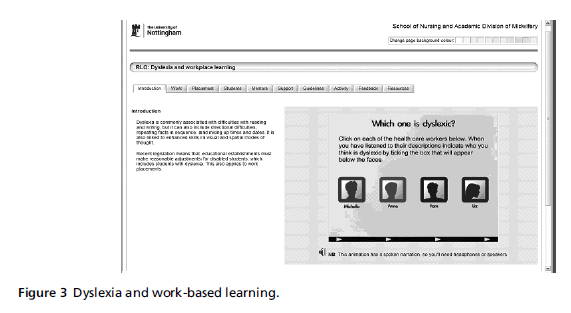
Figure three :Dyslexia and work-based learning.
Evaluation
Each RLO was packaged with a brusk online survey that was added in January 2006, for learners to complete. The survey was a tool available from an evaluation toolkit devised by the Centre for Excellence in Teaching and Learning for Reusable Learning Objects (www.rlo-cetl.air-conditioning.united kingdom of great britain and northern ireland). This evaluation strategy was based on activity theory and has been widely deployed (Morales et al, 2006). The tool consisted of 10 open and closed question types and used a iv-point Likert scale; information technology was short in order to encourage a response. The questions included the following: 'How do you rate the RLO?', 'How like shooting fish in a barrel was it to utilize?', 'How helpful has the RLO been for learning this subject?', 'Would y'all recommend it to others?', 'What did y'all like nigh?' and 'What did you not similar?' Other questions requested biographical information.
Data analysis
Responses to closed questions were collated automatically inside the survey management tool Zoomerang (www.zoomerang.com) and exported into Microsoft Excel. Open up responses were organised into key themes by one of the authors and shared amidst the others for verification. Quotations representing the key themes were later on selected (come across Table 1) and used aslope evidence fromthe literature to illustrate the key issues.
Results and discussion
At the time of writing this commodity, 608 people take used the RLOs and 33 (5%) have completed the feedback grade. This is a disappointingly low response charge per unit, but is not unusual for an optional survey of this kind. Figure 4 summarises the combined quantitative feedback for the 2 RLOs. Learners included students (53%), tutors (35%) and mentors (12%). In total, 39% were external to the host university; 96% said that they would recommend the RLOs to others. Overall the feedback was very positive, and individual comments suggest that the RLOs have raised awareness and increased understanding about dyslexia.
Many of the positive comments related to the underlying pedagogical design features of the RLOs (i.e. the ways in which the fabric was delivered as activities and exercises, visually and with commentary; meet Table 1, T2 and T3 columns 2 and 4). Visual learning approaches take been shown to raise learning by providing multiple representations of a topic and by supporting learner preferences (Ainsworth, 1999; Ainsworth and Loizou, 2003). Nonetheless, learning was not directly measured in this study. The visual and interactive elements along with the use of analogies and narratives to draw dyslexia seemed to contribute to the RLO users' positive impressions of the resources as illustrated by the quotes (encounter Table 1, T2 and T3 columns 2 and four), although some users would accept liked more detailed information. Learners who take more agile control of visual learning approaches are said to construct a deeper agreement of the subject (Farrell, 2006). The visual, sound and interactive nature of these RLOs ways that they have an entreatment for visual, auditory and kinaesthetic learners. This is an of import effect, bearing in mind data which advise that learning style is important in web-based east-learning (Manochehr, 2006). Some of the negative comments related to technical difficulties, such equally not beingness able to see the images or hear the audio (see Tabular array ane, T3 cavalcade 2) due to settings on the personal computer.
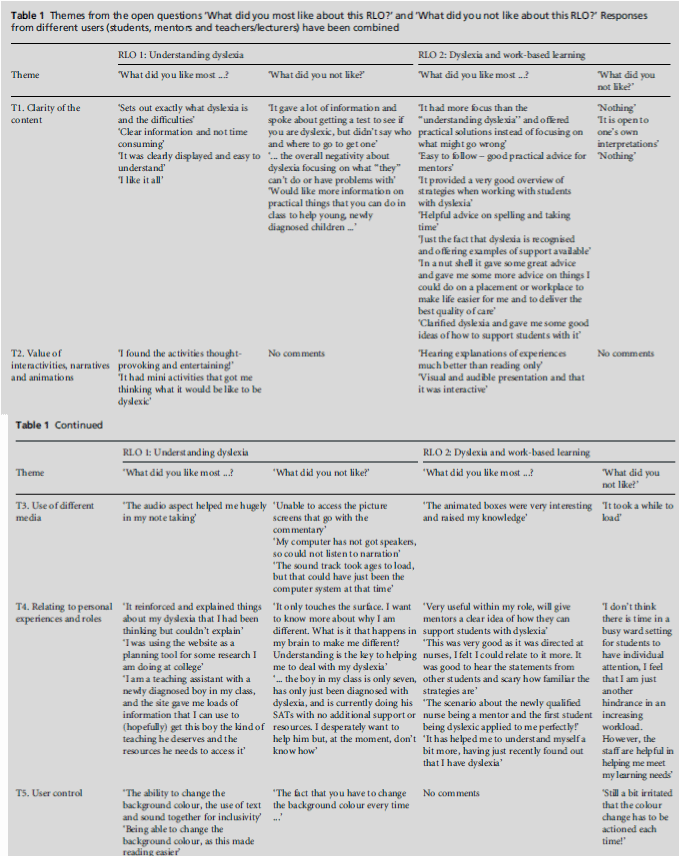
Tabular array 1: Themes from the open up questions ÃÆ'ƒÂ¢ÃÆ'‚€ÃÆ'‚ËœWhat did yous almost similar about this RLO?ÃÆ'ƒÂ¢ÃÆ'‚€ÃÆ'‚â„¢ and ÃÆ'ƒÂ¢ÃÆ'‚€ÃÆ'‚ËœWhat did you not like about this RLO?ÃÆ'ƒÂ¢ÃÆ'‚€ÃÆ'‚â„¢ Responses from different users (students, mentors and teachers/lecturers) accept been combined
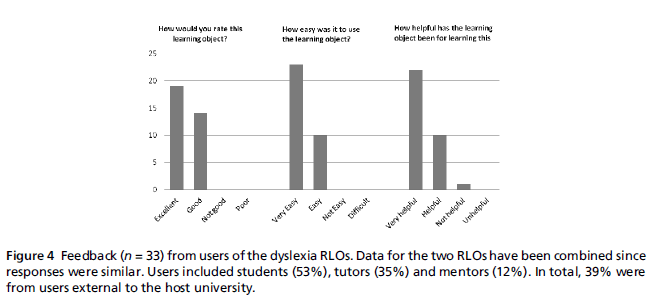
Table 4: Feedback (n = 33) from users of the dyslexia RLOs. Data for the two RLOs have been combined since responses were similar. Users included students (53%), tutors (35%) and mentors (12%). In total, 39% were from users external to the host university.
Previous investigations of the effectiveness of elearning technologies for health professionals and students identified a number of barriers to its success, including cost, poorly designed packages, lack of skills, the demand for a component of face-to-face didactics, the fourth dimension-intensive nature of eastward-learning, and computer anxiety (Childs et al, 2005; Wilkinson et al, 2004). The content of the RLOs in this study was pedagogically designed to accost many of these issues in that they were minor, self-contained and easy to employ (see Effigy 4). Our data propose that individual RLOs do non require more than around 15 minutes to complete. Therefore they do not require time-intensive input, which makes them more flexible for learners to utilise at work or at home, attributes that have previously been shown to be valued (Wharrad et al, 2001; Wilkinson et al, 2004). I of the reasons for making our resource freely and openly accessible was the difficulty in accessing materials that require usernames and passwords, and remembering how to access them. The RLOs tin can exist used flexibly, giving learners a sense of control, which is particularly important for healthcare students and staff who are coping with enervating curricula and work commitments (Childs et al, 2005; Windle et al, 2010a).
Enquiry findings from a report of the placement experiences of nursing students with dyslexia accept been successfully translated into web-based multimedia RLOs. The RLOs benefit healthcare students, their mentors and others interested in finding out more than virtually dyslexia. By releasing the RLOs equally open educational resources, the barriers associated with authentication and restrictive licensing are removed, enabling many more people to larn about dyslexia and the strategies for coping with it in the workplace.
Limitations
This was a small-scale evaluation study, and the intention is non to claim learning effectiveness or impact of the RLOs, simply simply to provide potential future users with some confidence in the quality of the RLOs based on user feedback.
Decision
Inquiry findings on the strategies used by nursing students with dyslexia, and their mentors, for coping with dyslexia in the workplace have been translated into two web-based RLOs. These RLOs were developed using a quality-controlled framework and released every bit open up educational resources. User feedback suggests that this grade of knowledge transfer of research findings is a useful approach.
Acquittance
The authors wish to thank Neil Duffin, freelance media developer, for providing ideas for images and animations and for developing one of the RLOs. Thanks are besides due to the Academic Support Unit of measurement at the University of Nottingham, to Joan Cook and Louise Bramley for peer reviewing the RLOs, and to pupil nurse Jessica Ellis for providing extensive comments from a pupil'southward perspective.
The authors are grateful to the various funders of different elements of the project, namely HEFCE Inability Fund, the University of Nottingham, and in particular the Higher Education Academy Educational activity Subject Centre, ESCALATE, for making information technology possible to develop the learning objects.
CONFLICTS OF INTEREST
None.
References
- Ainsworth SE (1999) A functional taxonomy of multiple representations. Computers and Education 33:131ÃÆ'ƒÂ¢ÃÆ'‚€ÃÆ'‚“52.
- Ainsworth SE and Loizou A (2003) The effects of selfexplaining when learning with text or diagrams. Cognitive Science 2:669ÃÆ'ƒÂ¢ÃÆ'‚€ÃÆ'‚“81.
- Boyle T, Cook J, Windle R et al (2007) Active methods for developing learning objects. In: Proceedings of the 23rd Ascilite Briefing. www.ascilite.org.au/conferences/sydney06/proceedings/pdf_papers/p64.pdf (accessed 21December 2010).
- Chew FS, Stiles RS, Joseph E et al (1994) Computer-assisted instruction with interactive videodisc versus textbook for educational activity radiology. Acadamic Radiology 1:326ÃÆ'ƒÂ¢ÃÆ'‚€ÃÆ'‚“31.
- Childs S, Blenkinsopp E, Hall A et al (2005) Effective elearning for health professionals and students ÃÆ'ƒÂ¢ÃÆ'‚€ÃÆ'‚“ barriers and their solutions. A systematic review of the literature ÃÆ'ƒÂ¢ÃÆ'‚€ÃÆ'‚“ findings from the HEXL project. Health InformationLibrary Journal 22(Suppl. 2):20ÃÆ'ƒÂ¢ÃÆ'‚€ÃÆ'‚“32.
- CowanM(2010) Guidance for Mentors of Student Nurses and Midwives: an RCN toolkit. world wide web.rcn.org.united kingdom/__data/assets/pdf_file/0008/78677/002797.pdf (accessed 21 December2010).
- Duncan C (2003) Granularization. In: LittleJohn A (ed.) Reusing Online Resources. London: Kogan-Page. pp. 12ÃÆ'ƒÂ¢ÃÆ'‚€ÃÆ'‚“19.
- Farrell M (2006) Learning differently. Eastward-learning in nurse education. Nursing Management 13:14ÃÆ'ƒÂ¢ÃÆ'‚€ÃÆ'‚“17.
- Illingworth K (2005) The furnishings of dyslexia on the work of healthcare workers and assistants. Nursing Standard 19(38):41ÃÆ'ƒÂ¢ÃÆ'‚€ÃÆ'‚“8.
- Koper EJR (2003) Combining re-usable learning resource and services to pedagogical purposeful units of learning.In: Littlejohn A (ed.) Reusing Online Resources: a sustainable approach to elearning. London: Kogan Folio.pp. 46ÃÆ'ƒÂ¢ÃÆ'‚€ÃÆ'‚“59.
- Lymn J, Bath-Hextall F and Wharrad HJ (2008) Pharmacology education for nurse prescribing students ÃÆ'ƒÂ¢ÃÆ'‚€ÃÆ'‚“ a lesson in reusable learning objects. BMC Nursing 7:2 doi:10.1186/1472ÃÆ'ƒÂ¢ÃÆ'‚€ÃÆ'‚“6955ÃÆ'ƒÂ¢ÃÆ'‚€ÃÆ'‚“7ÃÆ'ƒÂ¢ÃÆ'‚€ÃÆ'‚“ii.
- Manochehr N-Northward (2006) The influence of learning styles on learners in e-learning environments: an empirical study.CHEER 18:10ÃÆ'ƒÂ¢ÃÆ'‚€ÃÆ'‚“14.
- Millward LJ, Bryan 1000, Everatt J et al (2005) Clinicians and dyslexia ÃÆ'ƒÂ¢ÃÆ'‚€ÃÆ'‚“ a calculator-based cess of one of the key cognitive skills involved in drug assistants. International Periodical of Nursing Studies 42:341ÃÆ'ƒÂ¢ÃÆ'‚€ÃÆ'‚“53.
- Morales R, Carmichael P, Wharrad H et al (2006) Developing a multi-method evaluation strategy for
- reusable learning objects: an approach informed by cultural-historical action theory. In: Proceedings of the 1stEuropean Practice-Based and Practitioner Enquiry ConferenceÃÆ'ƒÂ¢ÃÆ'‚€ÃÆ'‚“ Improving quality in instruction and learning:developmental work and implementation challenges. Leuven,Belgium: University of Leuven.
- Irish potato F (2008) The clinical experiences of dyslexic healthcare students. Radiography fifteen:341ÃÆ'ƒÂ¢ÃÆ'‚€ÃÆ'‚“4.
- PriceGand GaleA (2004) The impact of the dyslexic profile onclinical placement practice of dyslexic nursing trainees:pedagogical issues and considerations. Paper presented at Fifth World Congress on Dyslexia, Thessalonika, Greece,23ÃÆ'ƒÂ¢ÃÆ'‚€ÃÆ'‚“27 Baronial 2004.
- Sanderson-Mann J, Wharrad HJ and McCandless F (2012) An empirical exploration of the impact of dyslexia on placement-based learning, and a comparison with nondyslexic students. Diversity and Equality in Wellness and Care 9:89ÃÆ'ƒÂ¢ÃÆ'‚€ÃÆ'‚“99.
- Shellenbarger T (1993) Helping the dyslexic educatee. Nurse Educator 18:10ÃÆ'ƒÂ¢ÃÆ'‚€ÃÆ'‚“13.
- Snowling M (2000) Dyslexia. Oxford: Blackwell.
- Thatcher JD (2006) Computer blitheness and improved educatee comprehension of bones science concepts. Periodical of the American Osteopathic Association 106(1):9ÃÆ'ƒÂ¢ÃÆ'‚€ÃÆ'‚“14.
- Wharrad HJ, Kent C, AllcockNet al (2001) A comparison ofCAL with a conventional method of delivery of cell biology to undergraduate nursing students using an experimental design. Nurse Education Today 21(vii):579ÃÆ'ƒÂ¢ÃÆ'‚€ÃÆ'‚“88.
- Wiley DA (2000) Connecting learning objects to instructional blueprint theory: a definition, a metaphor, and a taxonomy. In: Wiley DA (ed.) The Instructional Use of Learning Objects. https://reusability.org/read/#1 (accessed on 21 December 2010).
- Wilkinson A, Forbes A, Bloomfield J et al (2004) An exploration of iv web-based open and flexible learning modules in post-registration nurse education. International Journal of Nursing Studies 41:411ÃÆ'ƒÂ¢ÃÆ'‚€ÃÆ'‚“24.
- Windle RJ, McCormick D, Dandrea J et al (2010a) The characteristics of reusable learning objects that enhance learning: a case study in health science education. British Periodical of Educational Technology no. doi: 10.1111/j.1467ÃÆ'ƒÂ¢ÃÆ'‚€ÃÆ'‚“8535.2010.01108.10
- Windle R, Wharrad HJ, McCormick D et al (2010b) Sharing and reuse in OER: experiences gained from open reusable learning objects in health. Periodical of Interactive Media in Education JIME https://jime.open up.air conditioning.uk/2010/04 (accessed 23 November 2011).
- Wright D (2000) Educational support for nursing and midwifery students with dyslexia. Nursing Standard 14(41):35ÃÆ'ƒÂ¢ÃÆ'‚€ÃÆ'‚“41.
Source: https://www.primescholars.com/articles/using-reusable-learning-objects-to-raise-awareness-and-disseminate-research-findings-about-the-impact-of-dyslexia-on-pla-94578.html
0 Response to "Medicine and the Mediaã¢â‚¬â€Âmental Illness as Metaphor Yet Again"
Post a Comment